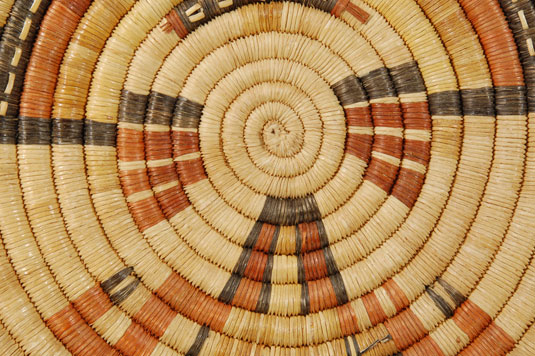Hopi 2nd Mesa Coiled Plaque with Palhikmana Design [SOLD]
+ Add to my watchlist Forward to Friend
- Category: Trays and Plaques
- Origin: Hopi Pueblo, Hopituh Shi-nu-mu
- Medium: Galleta grass, Yucca leaves
- Size: 16” diameter
- Item # C3636A SOLD
The Hopi from the Second Mesa villages of Shungopavi, Shipaulovi, and Mishongnovi have made coiled basketry for more than a hundred years and those made today are made in the same manner as before. Galleta grass is gathered in July and August for use as the foundation or warp of the basket. Traditionally, the leaves of the Yucca plant, which will be used for the weft of the basket, are not gathered until after the katsinas depart the Mesa in mid-July. Now, however, so few yucca plants grow on the reservation, the women go as far as Santa Fe, New Mexico to gather yucca leaves, so the restriction on gathering them before Niman Ceremony does not apply.
Now that the materials have been gathered, the most tedious part of basket making begins, that is the preparation of the grasses and yucca leaves for the warp and weft. The galleta grass needs no preparation but the yucca leaves do. The leaves are first split and cleaned and then laid out to begin the process of turning yellow or bleaching white. Each yucca leaf is split into widths of no more than 1/8th inch. The red dye used for coloring the yucca leaves is gathered from one of two plants that grow on the Mesa. Hopi sunflower seeds are used for dying the yucca leaves black.
The coiling technique used for these Native American baskets is a stitching process where the yucca leaf is rolled over the bundle of warp grass and interlocked into the previous row. Plaques such as this one are designed in the mind of the weaver and the design develops from the inner coil to the outer coil without a written pattern. A 16-inch plaque such as this could easily take 4 to 6 weeks of weaving, following several weeks of material gathering and preparation.
Many baskets woven are not for sale but are for ceremonial or obligatory paybacks among the Hopi. If a nephew takes food to an aging aunt on a regular basis, she then would make a basket to give him as payback. If the father of the groom weaves the wedding attire for the bride, her family them makes baskets as payback. Baskets are used in women’s dances and as gifts to be thrown from rooftops during plaza ceremonies. Many baskets are made for sale too.
Condition: very good condition but with about 4 stitches missing on the outer rim, a minor loss.
Recommended Reading: Hopi Basket Weaving: Artistry in Natural Fibers by Helga Teiwes
Provenance: from the estate of a New York family

- Category: Trays and Plaques
- Origin: Hopi Pueblo, Hopituh Shi-nu-mu
- Medium: Galleta grass, Yucca leaves
- Size: 16” diameter
- Item # C3636A SOLD



